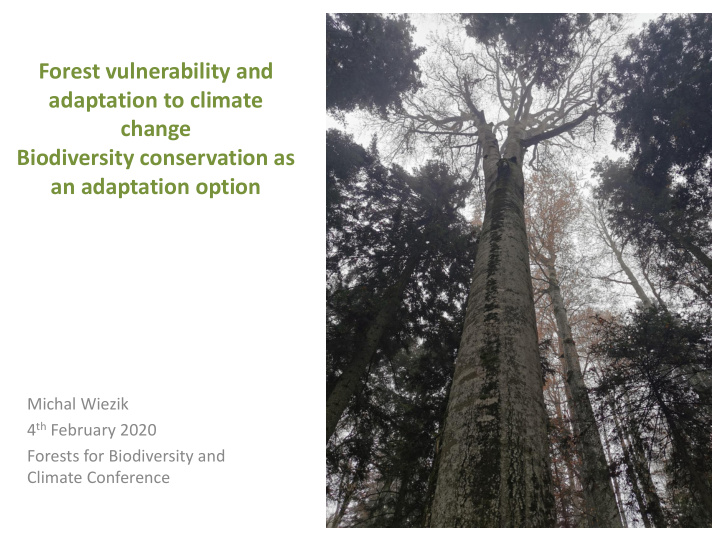



Forest vulnerability and adaptation to climate change Biodiversity conservation as an adaptation option Michal Wiezik 4 th February 2020 Forests for Biodiversity and Climate Conference
Adapta Ada ptation of tion of for orest est(r (ry), y), ho how, , when hen and and to to wha hat? Moder Modern for orest estry Er Era appr pprox. 200 . 200 yrs
NO COUNTRY FOR OLD ... FOREST? 0 100 400+ Sustainable forest management? What about the Environmental Pillar? To: Protect, sustain, and restore the health of critical natural habitats and ecosystems
COMPLEXITY of a forest Implications for ADAPTATION and RESILIENCE potential Role of BIODIVERSITY Architecture of the below-ground plant – fungus network in a temperate forest
What and where is the BIODIVERSITY? The role of Early seral stages and Old-growth forest
Managed forest, simplification of structure medium old-growth early Sukcesný čas
Typical structure of primary forest, with relatively open canopy (Pilsko, Slovakia)
Extream yet wide spread form of spruce plantation. Maximum stock vs minimum resilience, stability, biodiversity and aesthetics. (Collapse due tu climate change?)
Complex/Intact ecosystems HAVE GREATER CAPABILITY TO OVERCOME ENVIRONMENTAL STRESSORS, including changes to climate, than simplified (degraded) ones as they have inherent properties that enable them to maximize their adaptive capacity. - more above- and belowground carbon stored - more faunal complexity (helps carbon stoarage and sequestretion) - major carbon sequestration (soil, biomass, necromass) - regulating local and regional weather regime - generation of rain and reduced risks of drought - ensuring hydrological services - conserving biodiversity - consistently higher number of forest-dependent species - sustain important large scale ecological processes - higher functional diversity - higher intra-speciffic genetic dversity - higher chance for dispersal or retreating refugia - provision of key pollination and dispersal processes - human health benefits - and BEAUTY
Is Large scale canopy COLLAPSE a part of long term ecosystem RESILIENCE and ADAPTATION?
Recommend
More recommend